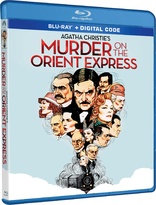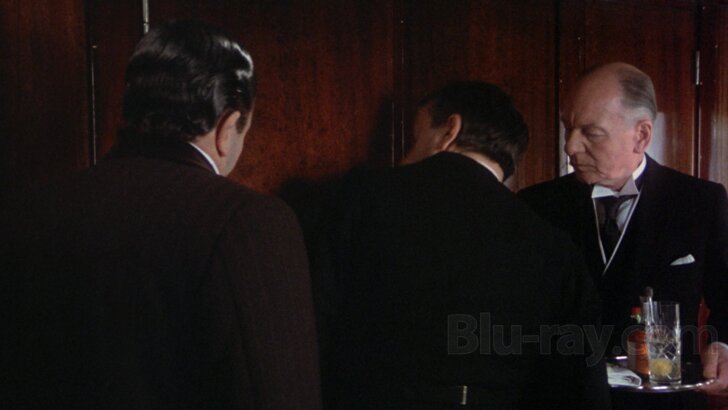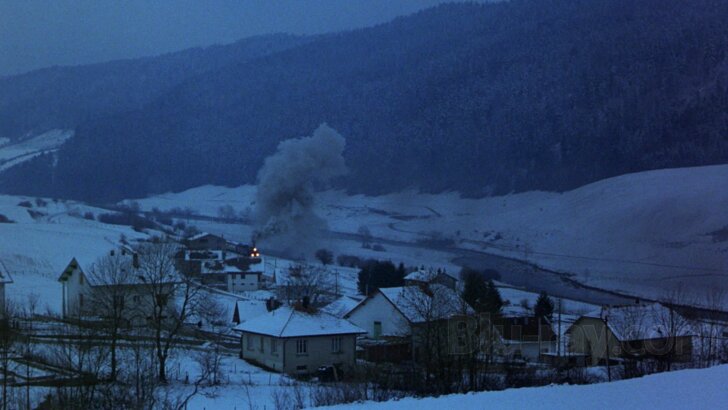Murder on the Orient Express Blu-ray Movie
HomeMurder on the Orient Express Blu-ray Movie 
Blu-ray + Digital CopyParamount Pictures | 1974 | 128 min | Rated PG | Feb 08, 2022

Movie rating
7.2 | / 10 |
Blu-ray rating
| Users | 0.0 | |
| Reviewer | 3.5 | |
| Overall | 3.5 |
Overview
Murder on the Orient Express (1974)
Famous detective Hercule Poirot is on the Orient Express, but the train is caught in the snow. When one of the passengers is discovered murdered, Poirot immediately starts investigating.
Starring: Albert Finney, Lauren Bacall, Martin Balsam, Ingrid Bergman, Jacqueline BissetDirector: Sidney Lumet
| Mystery | Uncertain |
| Period | Uncertain |
| Crime | Uncertain |
Specifications
Video
Video codec: MPEG-4 AVC
Video resolution: 1080p
Aspect ratio: 1.78:1
Original aspect ratio: 1.85:1
Audio
English: DTS-HD Master Audio 5.1 (48kHz, 24-bit)
English: Dolby Digital 2.0 (224 kbps)
French: Dolby Digital 2.0 (224 kbps)
Japanese: Dolby Digital 2.0
Subtitles
English, English SDH, French, Japanese
Discs
Blu-ray Disc
Single disc (1 BD)
Digital copy
Playback
Region A (locked)
Review
Rating summary
| Movie | 3.5 | |
| Video | 4.0 | |
| Audio | 4.5 | |
| Extras | 3.0 | |
| Overall | 3.5 |
Murder on the Orient Express Blu-ray Movie Review
Reviewed by Dr. Svet Atanasov February 8, 2022Sidney Lumet's "Murder on the Orient Express" (1974) arrives on Blu-ray courtesy of Paramount Home Media Distribution. The supplemental features on the disc include an archival program with Mathew Prichard; archival documentary on the making of the film; and vintage theatrical trailer. In English, with optional English, English SDH, French, and Japanese subtitles for the main feature. Region-A "locked".

Sidney Lumetís Murder on the Orient Express is a prime example that a great cast is not enough to deliver a great film. A good one is a possibility, but the stars would have to be ego-free and willing to remain silent for a long period of time.
The film opens with a couple of flashbacks that highlight important facts about a famous case: the kidnapping and killing of Daisy Armstrong, the daughter of a wealthy American couple. The facts are delivered in the form of quick newspaper headlines. The action then moves to Istanbul, where the famous Orient Express is prepped for a long journey. While final deliveries are made, various colorful characters board the train. Amongst them is the famous Belgian detective Hercule Poirot (Albert Finney).
Soon after the Orient Express leaves Istanbul, the wealthy businessman Ratchett (Richard Widmark) is found dead in his berth. Detective Poirot immediately steps up and quickly discovers that Ratchett is in fact an alias and that the dead man was responsible for the kidnapping of Daisy Armstrong. Encouraged by his close friend Bianchi (Martin Balsam), director of the Orient Express, who wants the murderer identified before the train reaches the next stop in Yugoslavia so that he can avoid embarrassment, Detective Poirot begins questioning the wealthy passengers.
Director Lumetís take on Agatha Christieís famous novel has an appropriate exotic flavor, but the filmís big stars quickly create the impression that they are having a rather difficult time coexisting in front of the camera. One reason why is the fact that there are so many of them that managing their time in a way that allows the viewer to remain interested in everything they do is virtually impossible. As a result, it often feels quite awkward to see the likes of Sean Connery and Jacqueline Bisset simply passing by or quietly observing the rest of the stars as they share important information with the Belgian detective. Another reason is the uneven characterizations. There are various sequences throughout the film where the humor is a lot more important than the suspense, but not all of the stars seem to agree. One of these stars is the great Ingrid Bergman, who won an Oscar for her performance, whose body language and facial expressions consistently demand a much more serious atmosphere.
Finneyís Poirot is a rather unusual character as well. At times, he has a commanding presence, but elsewhere he looks like an irritable old man who simply wants to be alone with his thoughts. Also, the man has a fake accent and frequently mumbles while he reveals to the viewer what his supposedly brilliant mind is telling him. He can be very entertaining at times, but it is not easy to fully embrace him as Christieís famous character.
Arguably the most convincing characterizations belong to Lauren Bacall's Mrs. Hubbard, Anthony Perkins' McQueen (played with a very familiar intensity), and Vanessa Redgrave' Mary Debenham.
Murder on the Orient Express was lensed by the great cinematographer Geoffrey Unsworth, who won Oscar Awards for his contributions to Bob Fosseís Cabaret and Roman Polanskiís Tess. The use of warm colors and soft lighting is most appropriate for the sense of nostalgia that permeates the film.
The excellent orchestral score was created by British composer Richard Rodney Bennett (John Schlesingerís Billy Liar, Ken Russellís Billion Dollar Brain).
Murder on the Orient Express Blu-ray Movie, Video Quality 

Presented in an aspect ratio of 1.78:1, encoded with MPEG-4 AVC and granted a 1080p transfer, Murder on the Orient Express arrives on Blu-ray courtesy of Paramount Home Media Distribution.
In previous years, we covered two different Region-B releases of the film that were produced by StudioCanal in the United Kingdom. The first release came out in 2014 and was part of the The Poirot Collection, a three-disc box set, while the second release came out in 2017. I still have both releases in my library and was able to do some direct comparisons with the U.S. release.
Each of the three releases offers a different technical pretension of the film. The master that was used to produce this upcoming U.S. release, for instance, isn't new, but it isn't the same old master that was used to produce the first release from StudioCanal. For example, there are some quite obvious color discrepancies between the two releases that affect the temperature of entire sequences in completely different ways. You can get an idea how different the grading is if you compare screencapture #10 with screencapture #7 from our review of the first StudioCanal release. While revealing certain similarities, the second release from StudioCanal looks different as well. On the U.S. release delineation and depth typically range from good to very good, but due to the nature of the original cinematography there are some noticeable fluctuations. Also, there are no traces of problematic digital adjustments, but in darker areas some of the grain becomes a tad noisy. When it does, it is usually where the age of the master shows the most. However, on the U.S. release a lot of the darker footage holds up nicely and looks significantly better than it does on the first release from StudioCanal. When the U.S. release is compared to the second release from StudioCanal, this isn't the case -- while not dramatically better, the second release, which was struck from a more recent remaster, reveals the best density levels and fluidity, and therefore produces the tightest visuals. On the U.S. release highlights can be rebalanced too, though there is plenty of soft light that hides quite well this particular limitation on the existing master. Image stability is very good. To sum it all up, the U.S. release offers a fine organic presentation of the film, but there is certainly room for meaningful improvements that can give the film a fresher and ultimately all-around more pleasing appearance. My score is 3.75/5.00. (Note: This is a Region-A "locked" Blu-ray release. Therefore, you must have a native Region-A or Region-Free player in order to access its content).
Murder on the Orient Express Blu-ray Movie, Audio Quality 

There are four standard audio tracks on this Blu-ray release: English: DTS-HD Master Audio 5.1, English: Dolby Digital 2.0, French: Dolby Digital 2.0, and Japanese: Dolby Digital 2.0. Optional English, English SDH, French, and Japanese subtitles are provided for the main feature.
I chose to view the film with the DTS-HD Master Audio 5.1 but kept switching to the Dolby Digital 2.0 track, which is supposed to be restored. I probably overdid the switching quite a bit, but I feel that it was worth it. Why? Because I want you to know that even though the Dual Mono track is only lossy, it is very, very nice, so if you are a purist, do not automatically dismiss it. (I even did some tests with the DTS-HD Master Audio 2.0 track from the remastered StudioCanal release and can confirm that there isn't a dramatic difference between the two). The DTS-HD Master Audio 5.1 track clearly has an expanded range of nuanced dynamics, but it did not convince me that it can be the go-to track when viewing the film. Once again, I did a lot of switching between these two tracks and I would be perfectly fine viewing the entire film with the lossy Dual Mono track. Unless you have already made up your mind, you should experiment with them as well.
Murder on the Orient Express Blu-ray Movie, Special Features and Extras 

- Trailer - a vintage U.S. trailer for Murder on the Orient Express. In English, not subtitled. (3 min).
- Agatha Christie: A Portrait - in this archival featurette, Mathew Prichard discusses the life and legacy of his famous grandmother, Agatha Christie. Additionally, Mr. Prichard addresses the legendary Belgian character Hercule Poirot and his period environment. In English, not subtitled. (10 min).
- Making Murder on the Orient Express - this archival program takes a closer look at the production of Murder on the Orient Express. It features numerous clips from archival interviews with director Sidney Lumet and cast and crew members. It is broken into four episodes. In English, not subtitled. (49 min).
1. All Aboard!
2. The Ride
3. The Passengers
4. The End of the Line
Murder on the Orient Express Blu-ray Movie, Overall Score and Recommendation 

While certainly quite attractive at times, Sidney Lumet's Murder on the Orient Express is not a particularly convincing cinematic adaptation of Agatha Christie's classic novel. A lot of its troubles begin with Albert Finney's transformation into the famous Belgian detective Hercule Poirot, but you will not have to look too long and too hard to find plenty of other issues as well. On the other hand, I would not trade Lumet's adaptation for Kenneth Branagh's modern take on the same material, which does not even get the period atmosphere right. Paramount's release is sourced from an older but mostly good organic master, so if you enjoy Murder on the Orient Express pick up a copy for your library. RECOMMENDED.
Other editions
Murder on the Orient Express: Other Editions
Similar titles
Similar titles you might also like

Death on the Nile
1978

The Mirror Crack'd
1980

Evil Under the Sun
1982

Murder on the Orient Express
2017

Poirot: Murder on the Orient Express
2010

The Big Sleep
Warner Archive Collection
1946

Phantom Lady
1944

A Kiss Before Dying
1956

Lady in the Lake
1947

Motherless Brooklyn
2019

Harper
1966

An Inspector Calls
1954

Farewell, My Lovely
1975

Warning Shot
1967

I Confess
Warner Archive Collection
1953

Laura
Fox Studio Classics
1944

Where the Sidewalk Ends
Limited Edition to 3000 - SOLD OUT
1950

This Gun for Hire
1942

Crossfire
Warner Archive Collection
1947

Fallen Angel
1945
